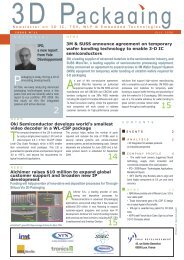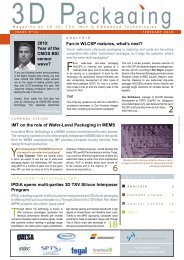September 2011 - I-Micronews
September 2011 - I-Micronews
September 2011 - I-Micronews
Create successful ePaper yourself
Turn your PDF publications into a flip-book with our unique Google optimized e-Paper software.
S E P T E M B E R 2 0 1 1 I S S U E N ° 1 3<br />
E D I T O R I A L<br />
Looking outside the mainstream at emerging<br />
approaches to improve PV efficiency<br />
Ramping low cost gigawatt-scale volume production has grown PV to a 40 GWp<br />
business, according to Yole Développement fi gures, but the focus is now turning<br />
to improving effi ciency to gain distinguishing competitive advantage in the crowded<br />
market. In this issue of PVManufacturing we look at the state of some emerging approaches<br />
to higher effi ciency solar installations, from High Concentration PV (HCPV) to developments<br />
in inkjet and laser components for PV equipment.<br />
…When overall enddemand<br />
slows down,<br />
these innovative<br />
solutions can help<br />
companies again<br />
generate growth…<br />
E V E N T S<br />
HCPV remains a tiny business of small-scale installations to date, but the sector made a big<br />
step up from mostly kilowatt-scale to multiple 1-2 megawatt-scale projects last year. The<br />
leading companies now have 10MW-scale or larger projects in the pipeline. Moving to these<br />
volumes means the HCPV sector will need to add volume automated production capacity and<br />
fi gure out how to work more closely with its supply chain to optimize component design for<br />
manufacturing—and that has potential to signifi cantly bring down costs.<br />
Some components suppliers are also trying to jumpstart co-design to improve performance by<br />
getting together to test, optimize and publish data on how different primary optics, secondary<br />
optics and multijunction cells work together. Concentrator Optics, Isuzu Glass and AZUR<br />
SPACE are testing results in mockup test HCPV modules made from their components, and<br />
next plan to work with equipment suppliers to design production systems for the optimal<br />
components.<br />
The recent growth of HCPV installations in the US is partly because of the favorable economics<br />
for the technology of high DNI desert climate conditions conveniently near big population<br />
centers that particularly need power for air conditioning late on summer afternoons when<br />
HCPV outperforms fl at plate PV, but it has also been spurred by government requirements<br />
for aggressive new renewable energy portfolio standards for utilities, and by local efforts to<br />
create manufacturing jobs. If the technology is going to compete more widely with fl at panel<br />
PV, it will now need “muscle, manufacturing and money” as Amonix CTO and chairman<br />
Vahan Garboushian says, to transition to a volume manufacturing business, and to keep<br />
improving effi ciency and cost as fast as the fl at plate PV sector does, when that much larger<br />
industry can pour vastly more resources into the effort.<br />
• European PVSEC<br />
<strong>September</strong> 5 to 9, <strong>2011</strong> – Hamburg, Germany<br />
• Semicon Europa<br />
October 11 to 13, <strong>2011</strong> – Dresden, Germany<br />
• PV Japan<br />
December 5 to 7, <strong>2011</strong> – Tokyo, Japan<br />
PLATINUM PARTNERS:<br />
The fl at panel PV side’s pursuit of higher effi ciencies of course continues to generate<br />
innovative alternatives to the common processes. And when overall end-demand slows<br />
down, these innovative solutions can help companies again generate growth. So we also take<br />
a look in this issue at recent developments in laser and inkjet technology that have interesting<br />
potential for new equipment processes to improve results. Controlled micromachining by<br />
ESI’s tailored-pulse fi ber laser is showing some interesting results for precise scribing and<br />
via drilling. Trident Solar is using its industrial stainless steel inkjet head that holds up to<br />
aggressive chemicals to develop a process for printing etchant and dopant for selective<br />
emitters by one pass of a single ink.<br />
Arnaud Duteil<br />
Market & Technology analyst<br />
Yole Développement<br />
duteil@yole.fr<br />
P V M a n u f a c t u r i n g 3<br />
For more information, please contact S. Leroy (leroy@yole.fr) or B. Stinson (stinson@i-micronews.com)
















